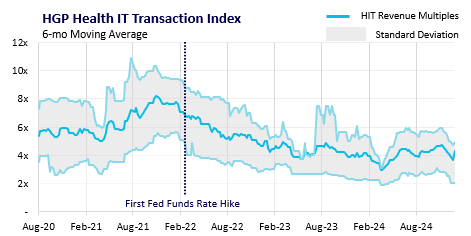The healthcare system is not immune to the near-term economic fallout of COVID-19, but should rebound and potentially be transformed after the easing of social-distancing measures. On March 18th, CMS announced “all elective surgeries, non-essential medical, surgical, and dental procedures be delayed during the 2020 Novel Coronavirus (COVID-19) outbreak.” The result is a massive loss of revenue for providers as well as the limited ability to sell products and services into care settings. The near-term pain is acute, both for providers and many of the vendors who serve them, particularly those with an emphasis on transaction- or revenue-based pricing models. There is a bright spot to all of this – CMS has already announced, if only temporarily, transformational waivers with a focus on telemedicine. The CMS guidance sets the table for an ongoing transformational shift to “hospitals without walls”, a trend that is likely to gain quick acceptance by providers and patients alike following the experience of the COVID-19 lockdown.
The general consensus is that most canceled visits and procedures will be rescheduled and made up for in the second half of 2020, putting a different and more positive strain on the healthcare system. However, the extent of this catch up will depend both on the length of the social-distancing period as well as the severity of the recession, which may impact discretionary procedures as well as employer-based healthcare insurance.
On March 30, CMS issued an unprecedented array of temporary regulatory waivers and new rules to equip the American healthcare system with maximum flexibility to respond to the COVID-19 pandemic. The waivers were allocated across four buckets:

Further Promote Telehealth in Medicare:
- CMS will pay for 80 additional services when provided via telehealth.
- Physicians can bill for telehealth visits at the same rate as in-person visits.
- Supervision of medical residents can be performed virtually.
- CMS is making it clear that clinicians can provide remote patient monitoring services to patients with acute and chronic conditions, and can be provided for patients with only one disease
- CMS is allowing physicians to supervise their clinical staff using virtual technologies when appropriate, instead of requiring in-person presence.
Put Patients over Paperwork:
- Medicare will pay for respiratory equipment for any medical reason.
- The time in which hospitals must give patients a copy of their medical record is increased.
- Hospitals will not be required to create written visitation policies for COVID-19 patients.
- CMS is providing temporary relief from many audit and reporting requirements
Increase Hospital Capacity – CMS Hospitals Without Walls:
- Hospitals can contract with ASCs to provide essential surgeries, for which Medicare will pay hospital rates.
- Hospital EDs can perform COVID-19 tests at drive-through testing sites.
- Ambulances can transport patients to a wide range of locations when other transportation is not appropriate, such as community mental health centers, FQHCs, physician offices, urgent care facilities, and ambulatory surgery centers.
- Hospitals can triage patients in state-approved community settings in a “hospitals without walls” model, such as ambulatory surgery centers, hotels, and dormitories.
- Physician-owned hospitals can temporarily increase their number of beds, ORs, and procedure rooms.
- Hospitals can bill for services that are performed outside their four walls, such as directing patients via telehealth to offsite screening locations.
Rapidly Expand the Healthcare Workforce:
- Hospitals can hire local clinicians.
- Hospital physician assistants and nurse practitioners can practice without physician supervision as permitted by state law.
- CRNA’s can work without being supervised by a physician.
- Hospitals are allowed to provide personal services for medical staff, such as meals or laundry service, while they are working at the hospital.
Noteworthy Transactions
Noteworthy M&A and Buyout transactions during the month include:
- Accolade, a provider of personalized health benefits and cost containment solutions, filed for a $100mm IPO. The company previously raised over $240mm and was valued at approximately $630mm in its most recent 2019 financing.
- GTCR-backed RevSpring acquired Loyale Healthcare, a provider of patient payment RCM solutions.
- Symphony AI acquired TeraRecon, a developer of 3D medical imaging processing systems.
- HealthStream announced a $25mm acquisition of NurseGrid, a nurse scheduling application and network.
- WebMD, a subsidiary of Internet Brands, acquired StayWell from Merck, which acquired the company into its Healthcare Services & Solutions division in 2016.
- Invitae announced the $95mm, $79mm, and $21mm acquisitions of Diploid, YouScript, and Genelex, respectively, which provide genomic interpretation software.
- Genstar Capital acquired ConnectiveRx, which offers tools for co-pays and medication assistance to pharma companies.
- Blackstone announced the acquisition of HealthEdge Software, a claims administration platform for healthcare payers.
Noteworthy Investments during the month include:
- Element Science, a vendor of wearables and monitoring solutions, completed a $146mm Series C led by Deerfield Management and Qiming Venture Partners.
- Lyra Health, which offers screening tools for behavioral health care, completed a $75mm Series C which valued the company at a reported $550mm led by IVP.
- Tempus, a genetic analytics platform, closed a $100mm Series G, with a reported $5 billion post-money valuation.
- Olive AI, an RPA solution targeting healthcare-specific process bottlenecks, closed a $51mm round led by General Catalyst.
Public Company Performance
HGP tracks stock indices for publicly traded health IT companies within four different sectors – Health IT, Payers, Healthcare Services, and Health IT & Payer Services. The chart below summarizes the performance of these sectors compared to the S&P 500 for the month of March:


The following table includes summary statistics on the four sectors tracked by HGP for March 2020:



